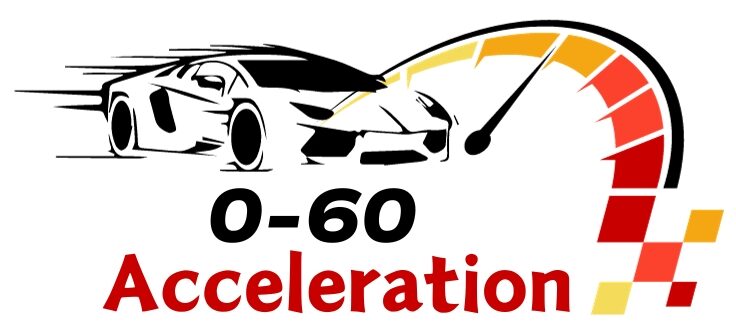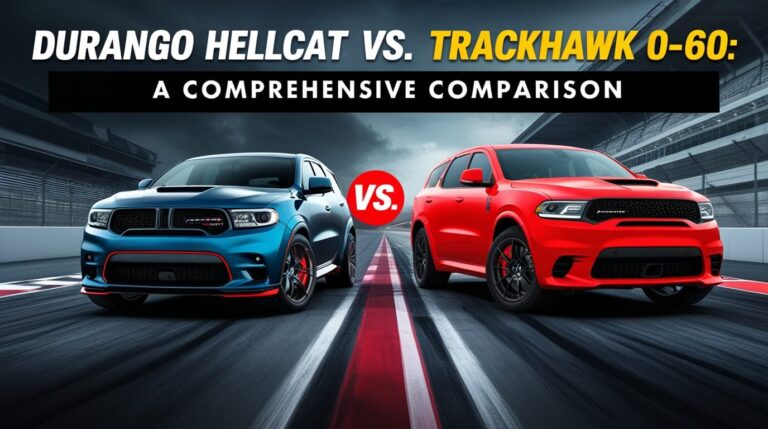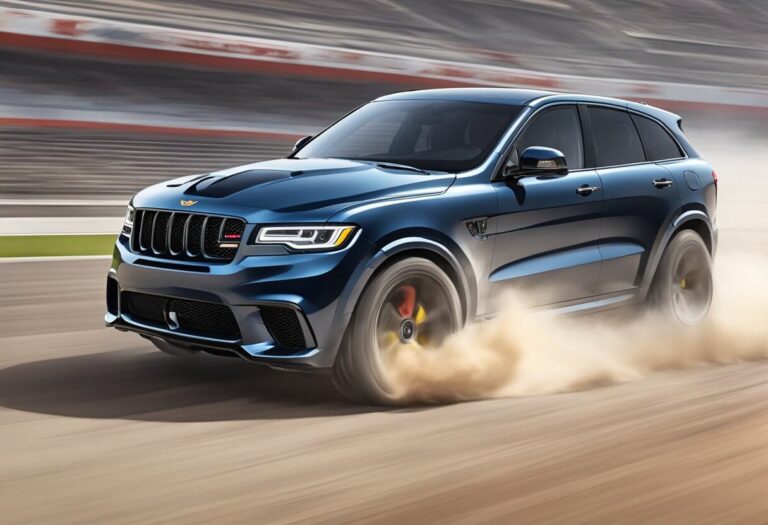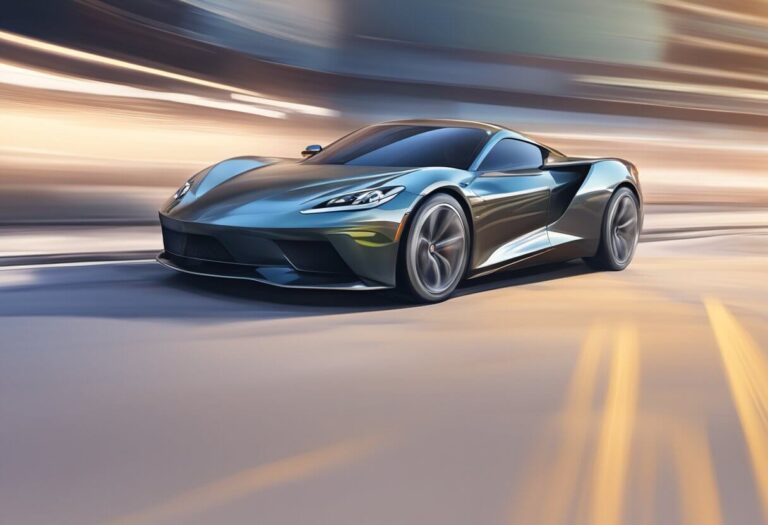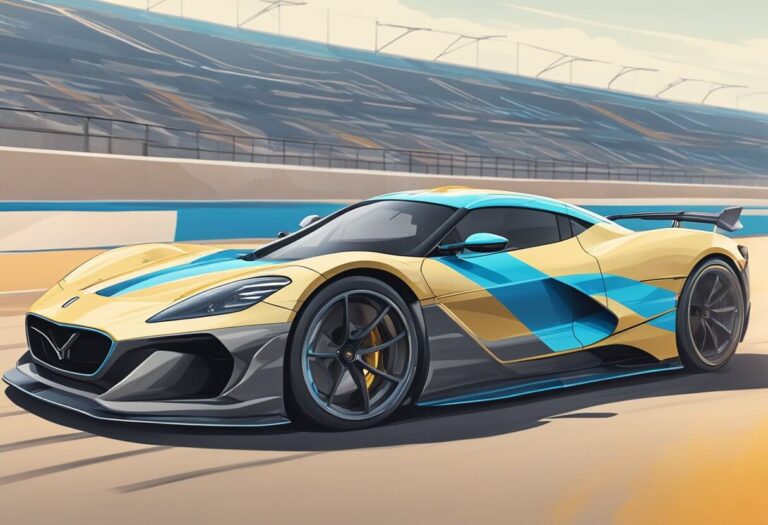
Are you in the market for a seriously quick hot hatch that can run circles around most sports cars from a stoplight? Look no further than the Volkswagen Golf R and its blistering 0-60 mph acceleration times.
This performance-oriented version of VW’s iconic Golf hatchback packs a powerful turbocharged engine, advanced all-wheel drive system, and a host of performance technologies. The result is mind-blowing straight-line speed and acceleration that will plaster a grin on any driving enthusiast’s face.
In this comprehensive review, we’ll dive deep into the Golf R’s 0-60 mph and quarter mile acceleration capabilities. We’ll analyze the key performance specs, engineering factors enabling its stunning quickness, and how it stacks up against rival hot hatches.
Let’s get started!
Golf R Performance Highlights
Before we get into the nitty-gritty acceleration numbers, here’s a quick overview of what makes the Golf R such a thrilling performance machine:
- 2.0L Turbocharged Engine: Pumping out 315 hp and 280 lb-ft of torque
- 4MOTION AWD: Permanent all-wheel drive system for superior traction
- 7-Speed DSG Transmission: Lightning-fast dual-clutch automatic
- Driving Modes: Including Race mode for maximum performance
- Launch Control: Optimizes engine revs and traction for blistering starts
- Top Speed: Electronically limited to 155 mph (168 mph on R Performance Pack)
With its potent powertrain, capable AWD system, and performance-enhancing tech, the Golf R is purpose-built to demolish straights and carve up back roads.
Pricing and Availability of the Golf R
The 2023 Volkswagen Golf R starts at $45,665 MSRP for the base trim with the 7-speed DSG transmission. If you prefer rowing your own gears, the 6-speed manual model starts at $46,890.
There is also an available R Premium trim starting at $50,290 that adds luxury amenities like a Harman Kardon sound system, heated rear seats, and more.
As for availability, the Golf R is sold across North America, Europe, and several other global markets. However, it may be subject to limited stock and waitlists due to high demand in some regions.
Putting the Pedal Down – Golf R 0-60 MPH and Quarter Mile Times
Now let’s get to the performance figures you’ve been waiting for – just how quickly can the Golf R sprint from 0 to 60 mph?
According to independent tests from major automotive publications, the DSG-equipped Golf R can blast from 0-60 mph in a scorching 3.9 seconds.
For some context, that’s about as quick as the previous generation Porsche 911 Carrera S. It’s also comparable to high-end sports cars like the C8 Corvette Stingray and Nissan GT-R NISMO.
If you opt for the 6-speed manual transmission Golf R, the 0-60 sprint takes a still-seriously-quick 4.9 seconds.
Either way, these are face-melting acceleration times that demolish most of the Golf R’s hot hatch rivals.
As for quarter mile performance, the DSG Golf R trips the lights in around 12.3 seconds at 114 mph. The manual isn’t far behind at 13.2 seconds at 106 mph.
To visualize those blistering times, here’s a handy acceleration specs table comparing the Golf R to some of its key competitors:
| Model | 0-60 MPH | Quarter Mile |
|---|---|---|
| VW Golf R (DSG) | 3.9 sec | 12.3 sec @ 114 mph |
| VW Golf R (Manual) | 4.9 sec | 13.2 sec @ 106 mph |
| Honda Civic Type R | 5.0 sec | 13.5 sec @ 107 mph |
| Hyundai Veloster N | 5.5 sec | 14.0 sec @ 101 mph |
| Subaru WRX STI | 5.0 sec | 13.3 sec @ 104 mph |
As you can see, the Golf R outguns almost every other turbocharged hot hatch in a straight drag race, especially with the rapid-fire DSG transmission.
What Makes the Golf R So Quick?
While the headline acceleration figures are undeniably impressive, you may be wondering – what exactly makes the Golf R such a rocket ship in a straight line?
The secret lies in a combination of Volkswagen’s sophisticated engineering and performance-oriented technologies working in harmony. Here’s a breakdown of the key factors:
Potent 2.0L Turbocharged Engine
Under the hood, the Golf R packs a 2.0L turbocharged four-cylinder engine churning out 315 hp and 280 lb-ft (295 lb-ft on overboost) of torque. That’s a monstrous amount of power routed to all four wheels via the 4MOTION AWD system.
While peak horsepower is always useful, the turbo engine’s broad torque curve is what really enables the Golf R’s brutal acceleration. Maximum torque comes on strong starting at just 1,700 RPM, providing relentless thrust from a dig.
Haldex 4MOTION AWD System
Instead of sending power solely to the front wheels like most hot hatches, the Golf R’s 4MOTION all-wheel drive system can route torque to the rear wheels as needed to maximize traction.
When accelerating hard from a stop, this AWD system can send upwards of 50% of the engine’s torque to the rear wheels to keep the hatchback hooks up and scrambling for grip. Less wheel slip means more efficient transfer of power to accelerate the Golf R forward.
Dual-Clutch DSG Transmission
While the manual 6-speed is a perfectly suitable pick for driving purists, the optional 7-speed dual-clutch DSG transmission is the real acceleration star of the show.
With lightning-fast gear changes happening in mere milliseconds, the DSG transmission always keeps the turbo four in its explosive powerband and firing on all cylinders. There’s simply less power lost to jerky, slower shifts compared to a conventional torque converter automatic.
Activating the DSG’s launch control mode also allows the Golf R to spool up the turbo and build revs before launching hard off the line. This helps shave vital tenths (or even a few seconds) off its 0-60 mph and quarter mile times.
Aerodynamics and Weight Distribution
Often overlooked acceleration factors, the Golf R’s sleek aerodynamics and balanced weight distribution work in its favor for rapid straight-line speed as well.
With a drag coefficient of just 0.32 cd, the Golf R can slice through the air with relative ease compared to blockier, less aerodynamic hot hatches. Less air resistance means less power is needed to keep accelerating.
Additionally, the 4MOTION AWD system’s rear power transfer helps offset the Golf R’s mild front weight bias. This balanced weight distribution improves traction and reduces wheelspin for optimized acceleration runs.
Driving Modes and Launch Control
Any serious performance car needs adjustable driving modes and launch control these days – and the Golf R delivers in spades.
Twisting the center drive mode knob to the “Race” setting stiffens up the suspension, remaps the steering and throttle response, and unleashes the full fury of the turbocharged engine for maximum performance. The climate control and fuel-saving engine stop/start functions also deactivate for uninterrupted power on demand.
With “Race” engaged, flicking the “ESC Sport” button initiates launch control mode. This allows the driver to build up revs while holding the brake pedal, with the car automatically transferring optimum power to each wheel when releasing the brakes.
Combine all these go-fast hardware and software features, and the Golf R becomes a devastatingly effective Point A to Point B missile on dry pavement.
Owners Rave About the Golf R’s Straight-Line Performance
But don’t just take my word for how exhilarating and potent the VW Golf R’s acceleration is. Owners are equally smitten with the hot hatch’s stonking straight-line pace in the real world.
On enthusiast forums like VWVortex and GolfMK7, owners consistently rave about the Golf R’s explosive acceleration and real-world performance. Many report being able to keep up with (or even gap) much more expensive sports cars and supercars when launching from a dig.
“I’ve blown the doors off Mustang GTs, Camaros, and even the odd Porsche 911 from a stoplight. The AWD grip and that torquey turbo engine are an intoxicating combination,” writes one enthusiastic Golf R owner.
Another echoed, “Launch control is insane in this thing. I’ve caught friends’ $80k sports cars napping more than once by burying the accelerator at a stop light…”
While most owners are thrilled with the Golf R’s ballistic acceleration out of the box, some have opted for bolt-on modifications and tuning to extract even more performance.
“With just an intake, intercooler, and tune, I shaved almost a full second off my 0-60 time versus stock. It pulls like a freight train now,” claimed one heavily modded Golf R owner.
Of course, not every owner review is 100% positive. A few have cited slight turbo lag or inconsistent AWD system performance in very low traction scenarios like heavy rain or loose surfaces.
Overall though, the overwhelming sentiment from Golf R owners is one of sheer delight and adrenaline rush when exercising its remarkable acceleration abilities in safe, legal environments.
How the Golf R Stacks Up Against Rival Hot Hatches
As we’ve clearly established, the Golf R is a downright missile in a straight line compared to most traditional hot hatches and sport compacts. But just how much quicker is it than key rivals from Honda, Hyundai, Ford and others?
To visualize the performance gap, let’s look at some more 0-60 mph and quarter mile comparisons versus leading competitors:
0-60 MPH Times
- Volkswagen Golf R (DSG): 3.9 seconds
- Honda Civic Type R: 5.0 seconds
- Hyundai Veloster N: 5.5 seconds
- Ford Focus RS: 4.7 seconds
- Subaru WRX STI: 5.0 seconds
As the numbers show, in the sprint to 60 mph, the DSG-equipped Golf R simply leaves most other hot hatches for dead. It outruns even the lauded Honda Civic Type R by over a second!
The only vehicle able to really hang with it is the previous-gen Ford Focus RS, with its trick AWD system and 2.3L EcoBoost four-cylinder. But even that potent hatch still lags 0.2 seconds behind the Golf R’s brutal acceleration.
Quarter Mile Times
- Volkswagen Golf R (DSG): 12.3 seconds @ 114 mph
- Honda Civic Type R: 13.5 seconds @ 107 mph
- Hyundai Veloster N: 14.0 seconds @ 101 mph
- Ford Focus RS: 12.7 seconds @ 112 mph
- Subaru WRX STI: 13.3 seconds @ 104 mph
The quarter mile gap is even more pronounced, with the Golf R clocking times on par with genuine muscle cars and affordable sports coupes. Its trap speed of 114 mph is a full 7 mph faster than the Civic Type R can muster.
Only the old Focus RS can even hope to stay in the Golf R’s mirrors, thanks to its torquey 2.3L turbo four and clever AWD setup. But it’s a mighty close race that easily goes to the Volkswagen if both drivers nail the launches.
Long story short, whether you’re looking at 0-60 mph or the quarter mile, the VW Golf R demolishes just about every other mass-produced hot hatch when it comes to straight-line acceleration. Its precision German engineering and advanced performance technologies place it in a class above traditional competitors in terms of brute speed.
Unleashing the Golf R’s Full Acceleration Potential
Of course, no matter how impressive a performance car’s factory acceleration times are, enthusiasts inevitably want to unlock even more speed and power through modifications.
Fortunately, the MK7/MK7.5 Golf R is an extremely tuner-friendly platform with a wide range of available go-fast bolt-ons to choose from. Here are some of the most popular mods to take your Golf R’s acceleration to the next level:
Performance Air Intakes An aftermarket performance air intake is usually one of the first and easiest upgrades. By allowing more cool air into the engine, these aluminum or carbon fiber intakes improve airflow for extra horsepower and torque on tap. Popular options include the Integrated Engineering or ECS Tuning intakes.
Upgraded Intercoolers The factory intercooler on the Golf R is decent, but can get heat soaked and reduce the effectiveness of the turbo after hard driving. An upgraded front-mount or top-mount intercooler helps keep intake air cooler and denser for more explosive acceleration.
ECU Tuning To take full advantage of new performance parts, tuning the engine control unit (ECU) is essential. Reputable tuners like APR, Unitronic, and IE can reflash the ECU to optimize ignition timing, boost pressure, and fueling for safe, sizeable horsepower gains.
Lightweight Wheels and Tires Those hefty OEM wheels and all-season tires are great for daily driving, but dedicated lightweight wheels and sticky summer performance tires will vastly improve launch traction and acceleration times.
Upgraded Clutch and Transmission Mounts If pushing serious power beyond stock levels, a beefier clutch pack and firmer transmission mounts will better handle the extra torque of the tuned engine.
Exhaust System A free-flowing cat-back or turbo-back exhaust lets the boosted four-cylinder engine breathe easier while adding an delightfully aggressive growl during acceleration runs.
With a few choice bolt-ons and a professional tune, it’s not uncommon for modified Golf Rs to shave another 0.5-1.0 seconds off their 0-60 mph and quarter mile times versus stock. Some particularly extreme builds have even cracked into the 11-second quarter mile territory!
Of course, modifying your Golf R does come with some trade-offs beyond reduced warranty coverage and higher running costs. The ride can become noticeably harsher, NVH levels may increase, and fuel economy will likely take a hit.
But for hardcore speed enthusiasts willing to make those compromises, the tuning potential waiting to be unlocked in the Golf R is immense. When modified properly, this pint-sized hot hatch can outrun bonafide sports cars costing twice or three times as much.
Pros and Cons of the Golf R’s Acceleration
At this point, I think we can all agree the Volkswagen Golf R has acceleration capabilities bordering on genuine supercar territory – at least in a straight line. But like any performance vehicle, there are both pros and cons to consider when it comes to its straight-line pace.
Pros:
- Blistering 0-60 and quarter mile times that outclass most competitors
- Combination of AWD grip and broad turbo torque curve for explosive launches
- Precise German engineering and performance tech features
- Still practical and comfortable enough for a daily driver
- Accessible performance for a relatively affordable price
Cons:
- Acceleration focused, so it can’t quite match lightweight sports cars in corners
- Even with modifications, some higher-end sports cars will still outrun it
- Ride may become overly harsh with bigger wheels, tires, and suspension upgrades
- Significantly increased running costs if tracking or hard driving regularly
While neck-snapping acceleration is clearly the Golf R’s forte, there’s no denying it also compromises slightly in some other areas that dedicated sports cars do not.
Its turbocharged four-pot and AWD system add notable weight and complexity compared to lightweight, minimalist performance vehicles. So while the Golf R will roast most competitors in a straight line, something more agile and featherweight like a Mazda Miata will have the advantage on tight, technical roads.
Additionally, the Golf R’s acceleration – while blisteringly quick for its class – does have limits. Genuine supercars and ultra-high-end sports cars costing well into the six figures will always be able to pull away once speeds crest 100+ mph.
So if money is no object and you demand ballistic speed at any velocity, a vehicle like a Porsche 911 Turbo S or Ferrari 488 Pista may prove more satisfying in the long run than a humble hot hatch like the Golf R.
